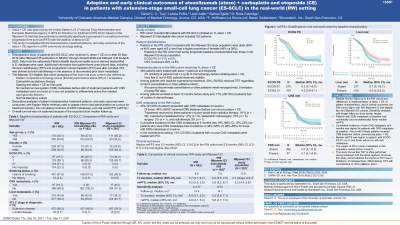Back

Industry Encore Posters
JL1001E: Adoption and early clinical outcomes of atezolizumab (atezo) + carboplatin and etoposide (CE) in patients with extensive-stage small cell lung cancer (ES-SCLC) in the real-world (RW) setting
Saturday, October 22, 2022
10:00 AM – 11:00 AM ET


Michele Puyear, PharmD
Medical Affairs Executive Director
Genentech
Poster Presenter(s)
Background
Based on the Ph 3 IMpower133 trial, atezo + CE was FDA/EMA-approved in 2019 for first line (1L) treatment (tx) of ES-SCLC. We explored clinical characteristics, tx patterns and early outcomes of the IMpower133 regimen in the RW setting.
Methods
Data from the nationwide Flatiron Health Electronic Health Record-derived de-identified US database were used. Patients (pts) with ES-SCLC who received 1L atezo + CE on or after 25 Sep 2018 through 30 April 2020 were followed until 30 April 2020. Pt characteristics, tx patterns and early outcomes were assessed, including time to last administration (TTLA) as a proxy for tx duration, cumulative incidence (CI) of CNS metastases (mets) and RW PFS (rwPFS).
Results
493 pts were included in the analysis. Pts in the RW cohort had worse prognostic baseline characteristics vs those in IMpower133. Notably, 65% vs 45% were aged ≥65 y, 27% vs 0 had ECOG PS 2+ and 20% vs 8% had CNS mets. In the RW, 17% of pts had >4 cycles of CE, while all pts in IMpower133 had 4 cycles per protocol. Among pts who reached maintenance tx, 30% received thoracic radiotherapy regardless of intent. Only 51% pts with baseline CNS mets received CNS tx before starting atezo + CE. In the maintenance setting, 13% of pts with no prior CNS mets were treated with prophylactic cranial irradiation (PCI). CI of new CNS mets at 6 mo was 38% in pts with baseline CNS mets vs 19% in pts without. CI of first CNS mets 6 mo after start of maintenance was 5% in pts with PCI vs 33% in pts without. TTLA and rwPFS are shown in the Table for the RW cohort and an IMpower133-eligible subgroup.
Conclusions
Despite shorter follow-up in the RW vs IMpower133 and differences in implementation of atezo + CE, RW results align with the trial eligible–like cohort. Rates of untreated CNS mets at baseline were high. The impact of PCI on brain mets in this population needs further analyses.
Table
JL1001E_table 1320435
To view the table, please click on this link from the e-poster gallery on jadprolive.com
Based on the Ph 3 IMpower133 trial, atezo + CE was FDA/EMA-approved in 2019 for first line (1L) treatment (tx) of ES-SCLC. We explored clinical characteristics, tx patterns and early outcomes of the IMpower133 regimen in the RW setting.
Methods
Data from the nationwide Flatiron Health Electronic Health Record-derived de-identified US database were used. Patients (pts) with ES-SCLC who received 1L atezo + CE on or after 25 Sep 2018 through 30 April 2020 were followed until 30 April 2020. Pt characteristics, tx patterns and early outcomes were assessed, including time to last administration (TTLA) as a proxy for tx duration, cumulative incidence (CI) of CNS metastases (mets) and RW PFS (rwPFS).
Results
493 pts were included in the analysis. Pts in the RW cohort had worse prognostic baseline characteristics vs those in IMpower133. Notably, 65% vs 45% were aged ≥65 y, 27% vs 0 had ECOG PS 2+ and 20% vs 8% had CNS mets. In the RW, 17% of pts had >4 cycles of CE, while all pts in IMpower133 had 4 cycles per protocol. Among pts who reached maintenance tx, 30% received thoracic radiotherapy regardless of intent. Only 51% pts with baseline CNS mets received CNS tx before starting atezo + CE. In the maintenance setting, 13% of pts with no prior CNS mets were treated with prophylactic cranial irradiation (PCI). CI of new CNS mets at 6 mo was 38% in pts with baseline CNS mets vs 19% in pts without. CI of first CNS mets 6 mo after start of maintenance was 5% in pts with PCI vs 33% in pts without. TTLA and rwPFS are shown in the Table for the RW cohort and an IMpower133-eligible subgroup.
Conclusions
Despite shorter follow-up in the RW vs IMpower133 and differences in implementation of atezo + CE, RW results align with the trial eligible–like cohort. Rates of untreated CNS mets at baseline were high. The impact of PCI on brain mets in this population needs further analyses.
Table
JL1001E_table 1320435
To view the table, please click on this link from the e-poster gallery on jadprolive.com

